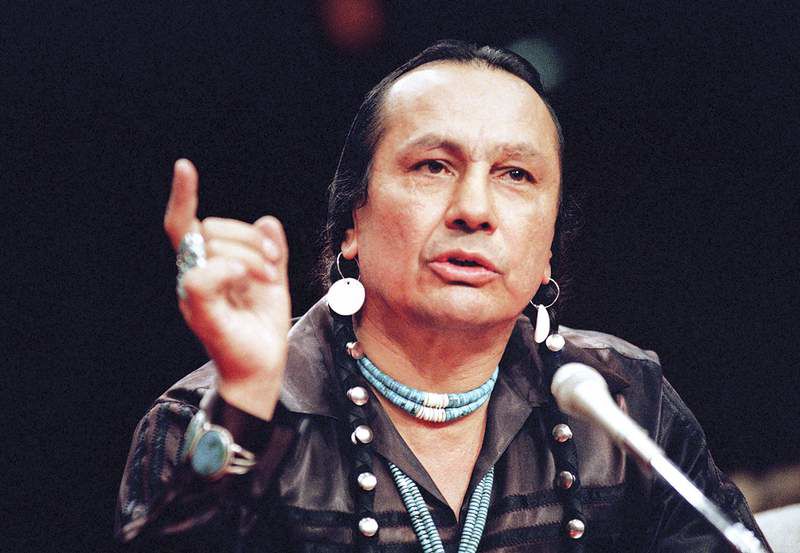Activist Means was a leader of uprising at Wounded Knee
Published 5:00 am Tuesday, October 23, 2012

- Russell Means testifies before Congress in 1989. A onetime leader of the American Indian Movement and a leader the 1973 uprising at Wounded Knee, Means went on to an acting career while continuing to advocate on behalf of Native American issues.
Russell Means, who gained international notoriety as one of the leaders of the 71-day armed occupation of Wounded Knee in South Dakota in 1973 and continued to be an outspoken champion of American Indian rights after launching a career as an actor in films and television in the 1990s, has died. He was 72.
Means died Monday at his home in Porcupine, S.D., on the Pine Ridge Reservation, said Glenn Morris, his legal representative.
Diagnosed with esophageal cancer in July 2011 and told that it had spread too far for surgery, Means refused to undergo heavy doses of radiation and chemotherapy. Instead, he reportedly battled the disease with traditional native remedies and received treatments at an alternative cancer center in Scottsdale, Ariz.
“I’m not going to argue with the Great Mystery,” he told the Rapid City Journal in August 2011. “Lakota belief is that death is a change of worlds. And I believe like my dad believed. When it’s my time to go, it’s my time to go.”
Means had been declared cancer free in April but suffered a recurrence of the disease in his lungs and died after contracting pneumonia, Morris said.
The nation’s most visible American Indian activist, Means was a passionate militant leader who helped thrust the historic and ongoing plight of Native Americans into the national spotlight.
A onetime con artist, dance-school instructor and computer programmer, Means was executive director of the government-funded Cleveland American Indian Center when he met Dennis Banks and other AIM founders in 1969.
In Cleveland, he founded the first AIM chapter outside Minneapolis, and he became the organization’s first national coordinator in 1971.
In November 1970, he joined fellow AIM members and other Native Americans in taking over a replica of the Mayflower in Plymouth, Mass. And in 1972 he participated in the seven-day occupation and trashing of the Bureau of Indian Affairs headquarters in Washington, D.C.
But the controversial and flamboyant activist with the trademark long braids gained his greatest notoriety at the trading post hamlet of Wounded Knee on the Pine Ridge Reservation.
The occupation of Wounded Knee by more than 200 AIM-led activists began in late February 1973 in the wake of a failed attempt to impeach tribal president Richard Wilson, whose Oglala critics accused him of corruption and abuse of power and said his private militia suppressed political opponents.
After the takeover of Wounded Knee, the historic site of the 7th Cavalry’s large-scale massacre of Sioux men, women and children in 1890, the area was cordoned off by about 300 U.S. marshals and FBI agents, who were armed with automatic weapons and aided by nine armored personnel carriers.
Among the occupiers’ demands were that congressional hearings be held to protect historical benefits held in trust by the U.S. government.
A federal grand jury reportedly indicted 89 people, including Means and Banks, for federal crimes in connection with the seizure and occupation of Wounded Knee.
Their widely publicized trial in 1974 on a variety of felony charges ended after eight months when a federal judge threw out the case on grounds of prosecutorial misconduct.
On the 20th anniversary of the occupation in 1993, former South Dakota Gov. Bill Janklow told The Associated Press that the fighting intensified racism, bitterness and fear in the state.
Means saw it differently, saying it was the Indians’ “finest hour.”
“Wounded Knee restored our dignity and pride as a people,” he told the Minneapolis Star Tribune in 2002. “It sparked a cultural renaissance, a spiritual revolution that grounded us.”
Tim Giago, the retired editor and publisher of the Native Sun News in Rapid City, S.D., takes a critical view of Means’ militant methods as an activist.
“I think he could have accomplished 10 times what he did eventually accomplish, which was to bring focus on Native American issues, if he had followed the path of Martin Luther King Jr. and Mahatma Gandhi instead of turning to violence and guns,” Giago, who was born and raised on the Pine Ridge Reservation, told the Los Angeles Times last year.
Means’ 1974 trial wasn’t the end of his legal troubles.
In 1976, he was acquitted of a charge of murder in the 1975 shooting death of a 28-year-old man at a bar in Scenic, S.D. He had been accused of aiding and abetting in the shooting for which another man was convicted of murder.
And in 1978, Means began a one-year prison term after being convicted of an obstruction of justice charge related to a 1974 riot between American Indian Movement supporters and police at the courthouse in Sioux Falls, S.D.
Through it all, he continued his high-profile activism.
In the mid-1980s, Means spent several weeks in the jungles of Nicaragua with the Miskito Indians in an attempt save them from what he said was “an extermination order” issued by Daniel Ortega’s Sandinista government.
In 1987, Means sought the presidential nomination of the Libertarian Party but lost to former Texas Congressman Ron Paul.
Means’ acting career began after he was approached by a casting director to play Chingachgook in the 1992 movie “The Last of the Mohicans.”
A string of more than 30 other roles in films and television followed, including playing a shaman in “Natural Born Killers” and providing the voice of the title character’s father in “Pocahontas.”






